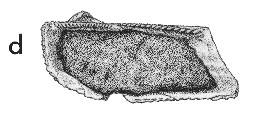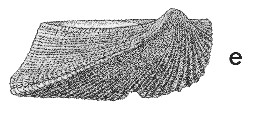
Revised descriptions of New Zealand Cenozoic Mollusca from Beu and Maxwell (1990)

 | Revised descriptions of New Zealand Cenozoic Mollusca from Beu and Maxwell (1990) | 
|
  (Pl. 38d): GS5435, V21/f8565, siltstone outcrop below Mason Ridge road, Maraekakaho, central Hawke's Bay, Nukumaruan (TM5118, GNS) |
  (Pl. 38e): GS5435, V21/f8565, siltstone outcrop below Mason Ridge road, Maraekakaho, central Hawke's Bay, Nukumaruan (TM5118, GNS) |
Beu & Maxwell (1990): Chapter 15; p. 306; pl. 38 d,e.
Synonymy: Arca cottoni Waghorn 1926, p. 234
Classification: Arcidae: Arcinae
Description: Small for genus (20-50 mm long), long and narrowly boat-shaped, with a long, shallow byssal excavation in mid-ventral margin, wide, horizontal ligamental area between hinge and narrow, protruding umbo, and very prominent, narrowly keeled ridge from umbo to postero-ventral corner. Hinge line straight, long; ventral margin parallel to hinge line; anterior end regularly curved below hinge; posterior margin quadrate, sloping backward ventrally. Sculpture of prominent, narrow radial costae over most of exterior, made scaly or finely nodulous by regular, low commarginal costellae; fine radial threads on postero-dorsal area, grouped into coarser costae. Hinge with many similar teeth, sloping radially outward at each end. Ligamental area with many shallow chevron-shaped grooves (diamond-shaped in articulated shells); up to 30 chevrons in large specimens. Adductor scars elevated, slightly roughened, subquadrate, with obvious growth tracks; no pallial sinus.
Comparison: Modern Arca species live byssally attached to hard substrates (rock, coral) in shallow water, often in crevices and surface hollows, and this was presumably also the habitat of New Zealand fossils, as all have wide byssal gapes in the centre of the ventral margin and were certainly byssally attached. The collection of much better material than the types shows that A. pittensis (Waipipian, Whenuataru Tuff, Pitt Island, Chatham Islands) differs from A. cottoni in its slightly shorter and wider form, wider ligamental area, more prominent umbonal-posterior keel, and weaker sculpture on the posterior area. The Early Miocene species A. subvelata was possibly ancestral to A. cottoni, and differs in its slightly shorter and wider form and fewer ligamental chevrons. A species of a very different group, A. chambersi, occurs sympatrically with A. cottoni at Waipipi; it is much shorter and wider and has only three to five ligamental chevrons. Beu (2006) pointed out that is is feasible that these late Neogene species in New Zealand are conspecific with those living in the southwest Pacific at present, but the taxonomy of Recent Arca species is so difficult and poorly understood that this possibility cannot be investigated at present.
Distribution: Opoitian(?); Waipipian-Castlecliffian; Ruakokopatuna Valley, northern Aorangi Range, southern Wairarapa (type) (Beu 1973b, p. 312 thought the type locality is probably Bull Creek, Haurangi Road, in the upper Ruakokopatuna Valley; early Nukumaruan). Abraded specimens reported from Kaawa Creek, southwest Auckland (Laws 1936a, p. 46) are apparently this species (Opoitian); moderately common in the Waipipi Shellbeds at Waverley Beach, west of Wanganui (Waipipian); rare in Nukumaruan siltstone between Petane limestone beds in central Hawke's Bay glacio-eustatic cycles, except that A. cottoni was common in a thin lens exposed temporarily in the centre of the outcrop of Devil's Elbow mudstone, at the top of the east-west face of Devil's Elbow hill, Napier-Wairoa highway (Nukumaruan); uncommon in shallow-water siltstone on Wainui Stock Route, Ohiwa Harbour, Whakatane (Castlecliffian; NZGS and National Museum of N.Z.). This is one of 3 species (the others being Taniella planisuturalis and Trivia zealandica) that seem to have retreated gradually northwards in New Zealand as Pleistocene sea temperatures fell, and are last recorded at Ohope Beach (mid-Castlecliffian).
Cite this publication as: "A.G. Beu and J.I. Raine (2009). Revised
descriptions of New Zealand Cenozoic Mollusca from Beu and Maxwell (1990). GNS
Science miscellaneous series no. 27."
© GNS Science, 2009
ISBN
978-0-478-19705-1
ISSN 1177-2441
(Included with a PDF facsimile file
copy of New Zealand Geological Survey Paleontological Bulletin 58 in CD version
from: Publications Officer, GNS Science, P.O. Box 30368 Lower Hutt, New
Zealand)